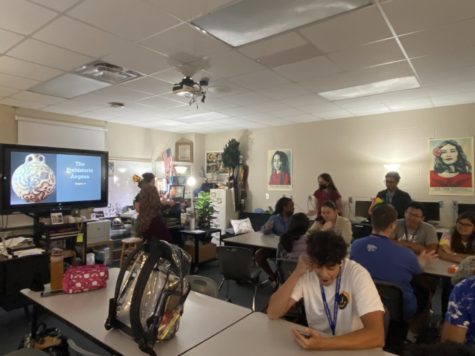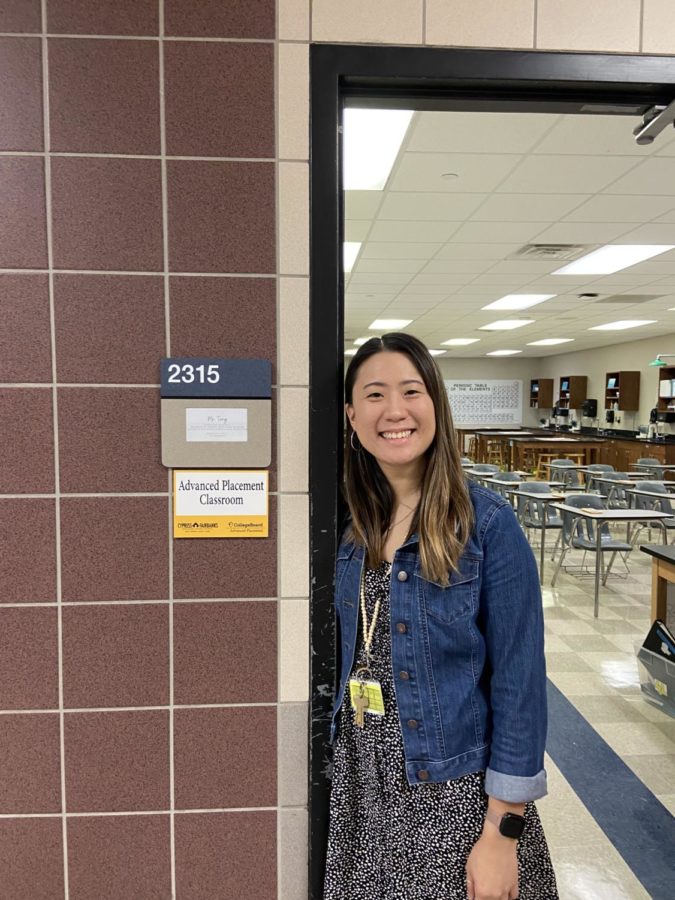Cy Creek Teachers Make Moves Toward a New Normal
Photo by: Anjum Alam
Tang pictured in the door frame in front of her classroom.
Carnaged magazine scraps. Works of students plastered onto the walls, some sculptures seated on shelves. Gertrude, the false skeleton, in the corner.
When walking into room 1461, it is evident that it belongs to Erica Chaikin, Digital Art and Art History teacher.
Yet, Chaikin cannot always be found in her room.
Chaikin’s struggle is one shared by many other teachers at Cy Creek this school year. With student enrollment on the incline, teachers have compensated by sharing their classrooms, moving into other classrooms during the day, and taking on new courses. Despite these challenges, Cy Creek’s teaching staff has adapted to changes with a positive outlook to find sustainable solutions.
Another teacher who has experienced significant changes is Chelsea Smith, a PACE teacher, the monitor of multiple Cy Creek organizations, and a ‘floater.’
‘Floating’ teachers move into several classrooms throughout the day. Floating is a fitting term for these teacher nomads.
“This is my first year where I’ve had to float as a teacher, going to different classes,” Smith said. “I thought it was going to be more stressful, but it’s really not too bad as a person who floats for just two class periods.”
With the amount of time teachers spend in their classroom, it is all the more important that they have their own secure space.
“Floating into another teacher’s room can be kind of uncomfortable and can be kind of inconvenient sometimes, but ultimately we’re just extra extra clean and organized,” Smith said.
For Smith, having a well maintained room is important not only for her classes, but to have some continuity for her clubs and organizations. Smith is one of many teachers who have commitments to extracurriculars at Cy Creek.
“As of right now, I work with the Step Team, I am trying to pick up another organization, and that’s pretty much it, but I do stay after school quite a bit for tutorials,” Smith said. “Especially recently, I’ve been staying till about 5:15 every day.”
Debbie Tang, a Chemistry teacher, had the common experience of moving to a new classroom this school year.
“Usually you come up in the summer and shift things around, but we couldn’t do that because of summer school, so it was a little challenging,” Tang said. “It was challenging, even though I was right next door, to move from one room to another.”
Tang is a returning Chemistry teacher at Cy Creek. However, this school year has been her first time teaching AP Chemistry, and in turn, her first year working with the College Board and preparing students for an end-of-year AP Exam.
“It is a little different just because the speed at which we go, and the content is a little more challenging,” Tang said. “But overall, it kind of aligns with Chemistry K, just to the next level.”
While Tang has transitioned into her new position smoothly, it is important to note why there was a vacancy in the first place.
“There are a lot of teachers who left, and so we have a lot of new teachers, which is nice,” Chaikin said. “I mean, they’re new and you have to teach them how to do things, but it also is nice in that we’ve got a lot of new people that are fresh and excited, and that helps.”
Yet, this hiring of a greater number of teachers has posed an unforeseen issue.
“If you looked at the master schedule in the Spring, we were 29 rooms short,” Chaikin said. “There [were] just 29 rooms that we didn’t have.”
With fewer returning teachers, administration had to increase their hiring, and, due to higher student enrollment, needed even more teachers than before. To compensate for this increase in staff, teachers now have to float throughout the day, split classrooms straight down the middle, and take on brand new course loads.
“The problem is not going away,” Chaikin said. “Maybe it will for me, but it’s not going to in general because this freshman class has four years here.”


Despite all of this change and uncertainty, Cy Creek teachers have risen to the challenge and are working toward a cohesive teaching community.
“I think the teachers that stayed are ones that are more dedicated,” Chaikin said. “I love my Creek Peeps.”
Floating requires teachers to work more closely together throughout the day.
“Luckily, the person who floats into my room and the person whose room I float into, I have good communication with,” Chaikin said. “We had to set some boundaries.”
Mutual trust and effective communication have been vital to ensuring this adjustment period is successful for everyone involved, including for Smith and the floating teacher she works with, fellow PACE teacher Gabriella Lammie.
“She is a part of my team, and I do trust her.” Smith said.
Smith’s experience with floating has been a brief one, but she is already seeing the benefits.
“My class sizes are actually quite smaller this year due to the extra teachers that they hired to take care of the new freshman population,” Smith said. “It has been a very nice experience to have less people in classes.”
But the issues with Cy Creek’s room shortage still remain, causing many disruptions for those who have had to uproot themselves and move classrooms.
“It was a bit of a challenge,” Tang said.“It’s kind of like when you think about when you live in your own house, you accumulate things, and you don’t realize you’ve accumulated so much stuff until it’s time to get up and move.”
For most teachers like Tang, there’s little that compares to the feeling of having a room, the freedom to make a space unique and true to the teacher.
“In a perfect world, every teacher has a classroom and every teacher has their conference period off in their classroom,” said Chaikin. “It’s very rare [for] a teacher right now who doesn’t have someone floating in during their conference period.”
Now more than ever, it is important for teachers to look to the future and to continue supporting each other..
“I don’t think it’s a great long-term solution, so we’ll have to see what next year brings,” Chaikin said.









